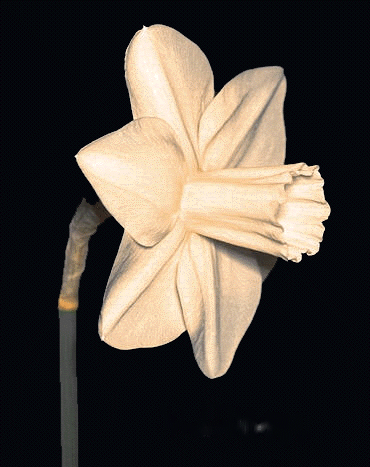 Daffodil
Classification
Daffodil
Classification Daffodil
Classification
Daffodil
ClassificationDaffodils are very popular because they tend to "naturalize", they are naturally toxic to rodents, and they tolerate varying degrees of light. Let me first state that the terms "daffodil", "jonquil", and "Narcissus" all refer to the same plant. Today I shall call them daffodils.
I dedicate this column to my late great-aunt Bess. Bess was a very special person who gave me the chart from the American Daffodil Society from which I will break the daffodils into divisions for your use today. Bess was a gracious lady who played a mean game of bridge. Bess was also a liberated woman before being such was cool. Living to near 90, Bess screwed up the curve by proclaiming that a good high ball and a cigarette contributed to her longevity. And Bess loved gardening.
The term "naturalizing" regarding bulbs means that they tend not to crowd themselves out through underground multiplication, thus lasting for many years. Tulips are an example of a bulb which does not naturalize well. Each year the bulbs multiply, yielding more foliage and less blooms. Ultimately, the tulip fails to emerge and disappears due to overpopulation. If you wish to have long term tulips, stick with Darwins as they last the most years. The daffodil multiplies, but does not crowd itself out.
Rodents or "voles" can be a real problem for many bulbs, as they can be eaten prior to emergence. Occasionally an inquisitive squirrel might dislodge a daffodil from the soil, but they will not eat them as they are toxic to these furry little creatures. Daffodils are sun lovers with a very good shade tolerance. Life gets no better!
Daffodils are classified by "Divisions" for the purposes of judged competitions, as well as identification purposes. When selecting varieties of daffodils one should pay close attention to the Divisions. This is particularly important when you are trying to have a simultaneous mass bloom of mixed varieties. For example, if you buy a dozen "Trumpet" daffodils and a dozen "Tazetta" daffodils to plant in the same bed you will have only a brief overlap of the two as one fades and the other emerges. "Trumpets" are early blooming division and "Tazettas" are a late blooming division. Obtain two varieties of "Trumpets" for a mass effect. You may want the "Trumpets" and the "Tazettas" to extend your bloom time. If your goal is to have mass bloom, stick with one division of daffodil.
Some early divisions are "Trumpet", "Cyclamineus", and "Long (Large) Cup". Many of the smaller rock garden type daffs bloom in February in our area. The "Trumpet" and "Large Cups" generally bloom in March. Later divisions include "Double (flowering)", "Triandus", and "Jonquilla" all of which are particularly fragrant in early April. By studying labels closely, one can have many sizes and shapes of daffodils for a six week period. They're not just for Palm Sunday! Until next week.
photo: American Daffodil
Society
Andy Lynn